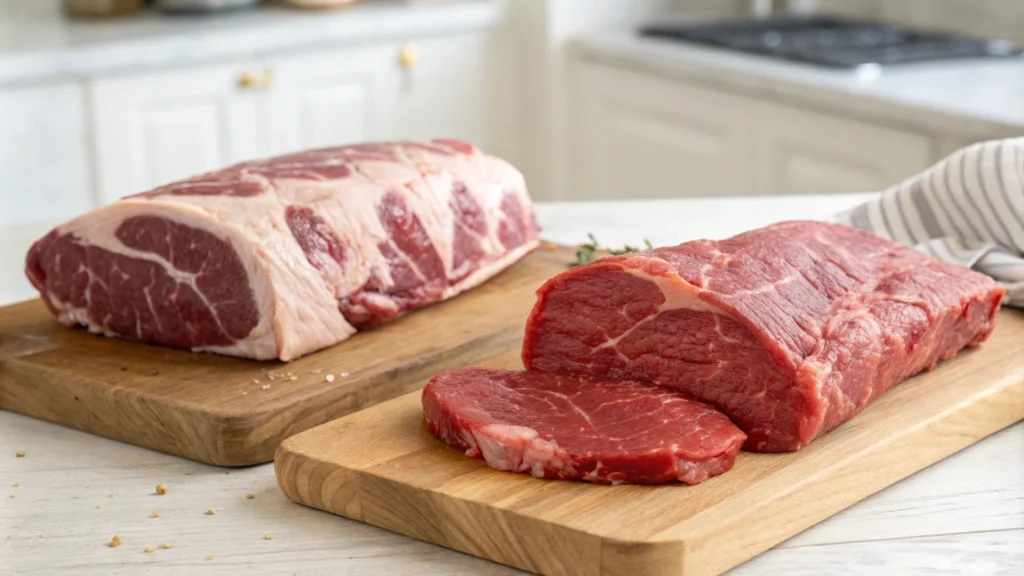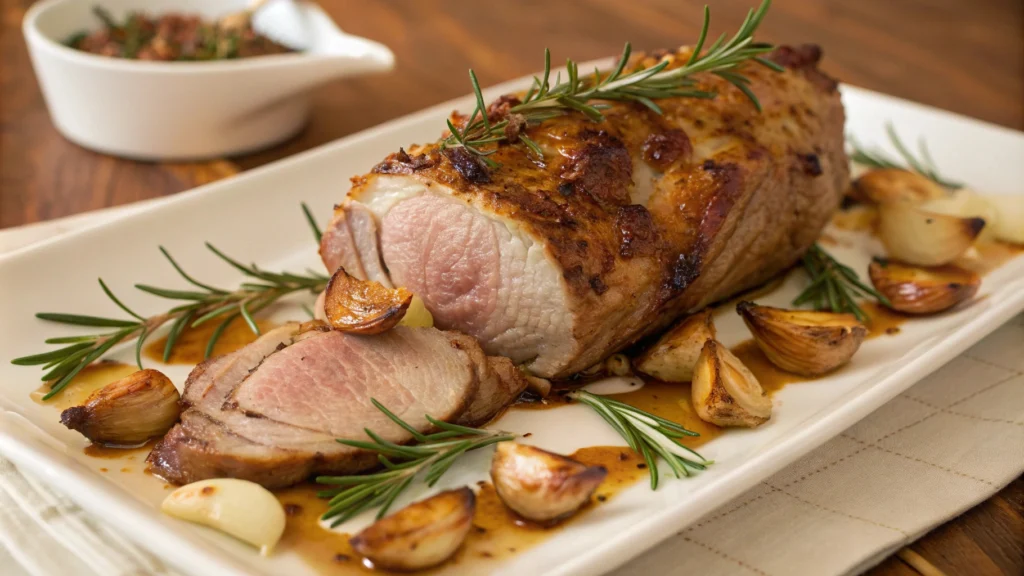Introduction
Is lamb healthier than beef? These two popular red meats are loved worldwide for their distinct flavors, textures, and nutritional benefits. Whether you’re enjoying a tender lamb chop or a juicy beef steak, both have unique qualities that make them a favorite in kitchens around the globe
When it comes to health, the question often arises: is lamb better for you than beef? Both meats are rich in important nutrients like protein, iron, and vitamins, but they differ in fat content, omega-3 levels, and overall nutrition. These differences can help you decide which one fits your diet and health goals better.
In this article, we’ll compare the nutritional value, health benefits, and environmental impact of lamb and beef. By the end, you’ll have the information you need to make a more informed choice for your lifestyle and dietary needs.
Nutritional Comparison of Lamb vs Beef
When comparing lamb and beef, it’s essential to understand their nutritional differences. Both are nutrient-rich and offer high-quality protein, but they vary in calorie content, fat composition, and micronutrient levels.

Calories and Protein Content
Both lamb and beef are excellent sources of protein, making them ideal choices for muscle repair and growth. However, their calorie content can differ depending on the cut:
- A 3-ounce serving of lamb provides around 250 calories and 25 grams of protein.
- A similar portion of beef contains about 215 calories and 22 grams of protein.
While lamb is slightly higher in calories, it delivers comparable or slightly higher protein levels, ensuring it remains a great choice for active individuals or those prioritizing muscle maintenance.
Fat Profiles in Lamb vs Beef
One of the most significant differences lies in their fat content:
- Lamb tends to have more saturated fat than lean cuts of beef. A 3-ounce serving of lamb contains approximately 17 grams of total fat, compared to 15 grams in beef.
- However, lamb—especially grass-fed lamb—contains higher levels of omega-3 fatty acids, which support heart health and reduce inflammation.
For those watching their saturated fat intake, trimming visible fat from lamb or choosing leaner cuts can help reduce overall fat consumption.
Vitamins and Minerals Found in Both Meats
Both lamb and beef are rich in essential nutrients, making them valuable for a balanced diet:
- Iron: Both meats provide heme iron, which is easily absorbed by the body and supports healthy red blood cells.
- Zinc: Crucial for immune function and wound healing, zinc levels in lamb and beef are similar.
- Vitamin B12: Lamb contains slightly more B12, a nutrient that aids in energy production and nerve health.
Compared to beef, lamb also contains more conjugated linoleic acid (CLA), a fatty acid linked to potential health benefits like weight management and improved heart health.
Health Benefits of Lamb
Lamb stands out as a nutrient-dense and heart-healthy option, particularly when it’s grass-fed. Its unique composition of healthy fats, vitamins, and minerals provides several advantages for those looking to optimize their diet.
Rich in Omega-3 Fatty Acids
One of lamb’s most notable health benefits is its higher concentration of omega-3 fatty acids, especially in grass-fed varieties. Omega-3s are essential fats known to:
- Support heart health by reducing inflammation.
- Improve brain function and cognitive health.
- Lower the risk of chronic diseases such as heart disease and arthritis.
Compared to beef, lamb typically offers more omega-3s due to its natural diet, as most lambs are grass-fed rather than grain-fed.
Grass-Fed Advantages
Grass-fed lamb not only has a richer flavor but also contains higher levels of conjugated linoleic acid (CLA). CLA is a type of fat that has been linked to several potential health benefits, including:
- Improved fat metabolism and weight management.
- Reduced risk of cardiovascular diseases.
Additionally, grass-fed lamb is free from many of the additives and hormones commonly found in grain-fed livestock, making it a cleaner and more natural choice for your meals.
Key Nutrients in Lamb
Lamb is packed with essential nutrients that support overall health and well-being:
- Vitamin B12: Lamb is an excellent source of B12, which boosts energy levels, supports red blood cell production, and maintains nerve health.
- Iron: With its high levels of easily absorbed heme iron, lamb helps prevent anemia and promotes better oxygen circulation in the body.
- Zinc: A key nutrient in lamb, zinc strengthens the immune system and aids in tissue repair and growth.
By incorporating lamb into your diet, you gain access to these vital nutrients, all of which are essential for maintaining energy, supporting immunity, and promoting overall vitality.
Health Benefits of Beef
Beef has long been a dietary staple, offering significant nutritional benefits, especially for those looking for lean protein and high iron content. While lamb excels in certain areas, beef brings its own unique advantages to the table.
Lean Cuts and Low-Calorie Options
One of beef’s primary benefits is the availability of lean cuts, which provide high protein content without excess fat:
- Cuts like sirloin, tenderloin, and eye of round are low in fat and calories, making them ideal for those managing their weight or heart health.
- A 3-ounce serving of lean beef contains approximately 150 calories and 26 grams of protein, offering an excellent protein-to-calorie ratio.
Protein for Muscle Growth and Repair
Beef is an exceptional source of high-quality protein, which is vital for:
- Building and maintaining muscle mass.
- Supporting tissue repair and recovery after exercise.
- Providing sustained energy throughout the day.
Athletes and physically active individuals often choose beef for its ability to fuel performance and aid in muscle recovery.
High Levels of Heme Iron
Beef is rich in heme iron, the most bioavailable form of iron, which:
- Helps prevent and treat anemia.
- Supports oxygen transport in the blood.
- Enhances energy levels and cognitive function.
Although lamb also contains heme iron, beef typically offers slightly higher levels, making it a strong choice for individuals prone to iron deficiency.
Lamb vs Beef : Key Differences to Know
While lamb and beef share similarities as nutrient-dense red meats, they differ in several key areas, including fat composition, nutrient density, and how they are typically raised. Understanding these distinctions can help you make informed dietary choices.
Fat Composition and Omega-3s
- Lamb: Lamb typically contains more saturated fat, but it also has higher levels of omega-3 fatty acids, especially if grass-fed. These healthy fats support heart health and reduce inflammation.
- Beef: Beef has less saturated fat in lean cuts and is a good choice for those aiming to reduce calorie and fat intake. However, it contains lower levels of omega-3s compared to lamb.
Nutritional Density
Lamb tends to have a slight edge in nutrient density due to its higher levels of:
- Vitamin B12 for energy production and brain health.
- Conjugated Linoleic Acid (CLA) for heart health and weight management.
Beef, on the other hand, provides:
- Higher levels of iron, making it an excellent choice for individuals with anemia or low energy.
- Lower calorie options in lean cuts, catering to those focused on weight management.
Grass-Fed vs. Grain-Fed Diets
- Lamb: Most lamb is grass-fed, contributing to its superior omega-3 content and cleaner fat profile. Grass-fed animals typically have fewer artificial additives or hormones, which appeals to health-conscious consumers.
- Beef: While some beef is grass-fed, much of it comes from grain-fed livestock. Grain-fed beef often has less omega-3 content but provides a more consistent taste and texture.
Which Meat is Better for Your Diet?
The choice between lamb and beef largely depends on your health goals, dietary needs, and personal preferences. Both meats offer unique benefits that can complement different types of diets. Here’s a closer look at when you might choose lamb or beef:
Heart Health and Omega-3s
- Choose Lamb: If you’re prioritizing heart health, lamb—especially grass-fed—may be the better choice due to its higher levels of omega-3 fatty acids. These healthy fats help reduce inflammation and lower the risk of cardiovascular disease.
- Choose Beef: Opt for lean cuts of beef, such as sirloin or tenderloin, if you’re watching your saturated fat intake. These cuts provide high protein content with minimal fat.
Weight Management and Fat Content
- Choose Lamb: Although lamb is slightly higher in fat, its nutrient-dense profile and smaller portion sizes make it a satisfying option. Trimming visible fat can also make lamb leaner.
- Choose Beef: Lean cuts of beef are ideal for calorie-conscious individuals or those aiming to reduce overall fat intake. The variety of lean options makes it easier to include beef in a weight-loss plan.
Nutrient Priorities Based on Your Needs
- Choose Lamb: For a boost in vitamin B12, zinc, and CLA, lamb is an excellent addition to your diet. These nutrients support energy production, immune health, and fat metabolism.
- Choose Beef: If you need higher levels of iron, particularly for anemia prevention or improved energy levels, beef is a better option.
Which Should You Choose?
Ultimately, the choice between lamb and beef depends on your personal health goals. If you’re looking for heart-healthy fats and a nutrient-dense option, lamb is a great choice. For lower-calorie, lean protein, beef might be the better fit. Incorporating a mix of both meats can provide the best of both worlds, ensuring a balanced diet rich in essential nutrients.
Sustainability and Ethical Factors
When choosing between lamb and beef, sustainability and ethical considerations often play a role. The environmental impact of raising livestock varies between these two meats, as does the ethical treatment of the animals.
Environmental Impact of Raising Lamb vs Beef
- Lamb: Lamb production typically has a higher carbon footprint per pound of meat compared to beef. This is due to the smaller size of sheep and their slower growth rate, which requires more resources relative to the amount of meat produced.
- Beef: Although beef has a slightly lower carbon footprint per pound, cattle farming still contributes significantly to greenhouse gas emissions, especially in industrial-scale operations. Grain-fed cattle also require more water and feed resources compared to grass-fed livestock.
Ethical Considerations in Farming Practices
- Lamb: Lamb is often raised on smaller farms and fed a grass-based diet, leading to fewer additives or artificial hormones. This makes lamb an appealing choice for those who prioritize natural farming methods. However, the ethical concerns around sheep farming, such as tail docking or lamb castration, may be worth considering.
- Beef: Ethical practices in beef production vary widely. Grass-fed and pasture-raised beef tend to have better welfare standards than grain-fed, industrially farmed beef. Certifications like “organic” or “animal welfare approved” can help identify more ethically sourced beef.
Sustainability Tips for Conscious Consumers
- Opt for grass-fed lamb or beef, as these animals are raised on natural diets and contribute less to resource-intensive farming.
- Purchase from local or sustainable farms to reduce the environmental impact associated with transportation.
- Consider reducing portion sizes and balancing meat consumption with plant-based proteins to minimize your overall carbon footprint.
The Bottom Line
While lamb generally aligns better with natural farming practices, it has a higher environmental impact per pound. Beef, on the other hand, offers more variety in sustainable options, especially when choosing grass-fed or organic. Conscious choices like buying local, grass-fed, or certified ethical products can reduce the environmental and ethical concerns of both meats.
Cooking and Flavor Differences
When it comes to cooking and flavor, lamb and beef offer unique characteristics that can influence your choice based on personal preferences and the dish you’re preparing.

How Cooking Methods Impact Nutrition
The way lamb or beef is cooked significantly affects its nutritional value and healthiness:
- Lamb: Roasting, grilling, and broiling are popular methods that retain flavor while minimizing added fats. Braising or slow-cooking lamb can bring out rich, tender textures but may increase fat content if additional oils or sauces are used.
- Beef: Similar to lamb, beef retains its nutritional value when grilled, roasted, or broiled. Lean cuts of beef are ideal for pan-searing or baking, while fattier cuts may work better in slow-cooked dishes.
Tip: To maximize health benefits, use minimal oil and opt for herbs, spices, and marinades to enhance flavor without adding excess calories.
Flavor Profiles of Lamb and Beef
- Lamb: Lamb has a distinctive, earthy, and slightly sweet flavor, often described as “grassy” due to its natural diet. It pairs beautifully with bold flavors like rosemary, garlic, cumin, and citrus. Lamb’s unique taste makes it a standout for Mediterranean, Middle Eastern, and Indian cuisines.
- Beef: Beef has a more neutral flavor profile, allowing it to adapt to a wide range of dishes and seasonings. Depending on the cut, beef can be rich and fatty (like a ribeye) or lean and mild (like sirloin). This versatility makes it a staple in American, Asian, and European recipes.
Which is Easier to Cook?
- Lamb: While lamb is often associated with gourmet dishes, it’s surprisingly easy to cook, especially when using simple methods like roasting or grilling. However, its shorter cooking time compared to beef requires attention to avoid overcooking.
- Beef: Beef offers a broader variety of cuts and cooking methods, making it slightly more accessible for everyday meals. From quick stir-fries to slow-cooked stews, beef adapts to almost any recipe.
Conclusion for Cooking and Flavor
Lamb’s bold, unique flavor makes it ideal for special occasions or dishes that call for a rich and earthy taste. Beef’s versatility and neutral profile make it a dependable option for a wide range of cuisines and cooking methods.
FAQs
What is the Best Cooking Method for Lamb?
The best cooking method for lamb depends on the cut. For tender cuts like lamb loin roast, oven roasting or grilling are excellent choices to retain their juiciness and flavor. For tougher cuts like lamb shoulder or shank, slow-cooking methods such as braising work best to break down connective tissue.
If you’re specifically preparing lamb loin roast, check out our detailed guide: Lamb Loin Roast: Simple Steps for a Perfect Dish.
Should You Sear Lamb Before Roasting?
Yes, searing lamb before roasting is highly recommended. Searing the meat at a high temperature caramelizes the surface, locking in juices and creating a flavorful crust. This step is especially beneficial when roasting tender cuts like lamb loin.
How to cook lamb loin roast ?
To cook lamb loin roast, start by seasoning it with your favorite herbs and spices. For extra flavor, sear the roast in a hot skillet for 2-3 minutes on each side before placing it in the oven. Roast at a moderate temperature until it reaches your preferred doneness (e.g., medium-rare or medium). Don’t forget to let the roast rest for 10-15 minutes after cooking to lock in its juices and ensure tender slices.
How to roast lamb loin chops ?
Roasting lamb loin chops is a quick and easy way to enjoy a flavorful meal. Start by seasoning the chops with salt, pepper, and your choice of spices. Sear them in a hot skillet for 2-3 minutes per side to achieve a golden crust. Then, transfer the skillet to a preheated oven at 400°F (200°C) and roast for 5-7 minutes, depending on how well-done you like your lamb.
